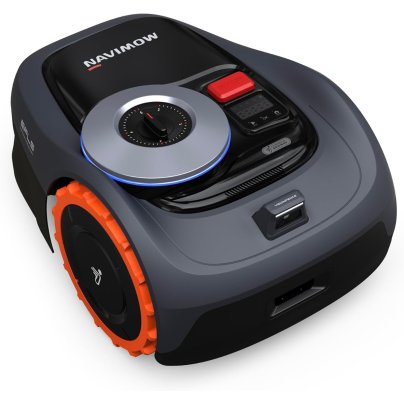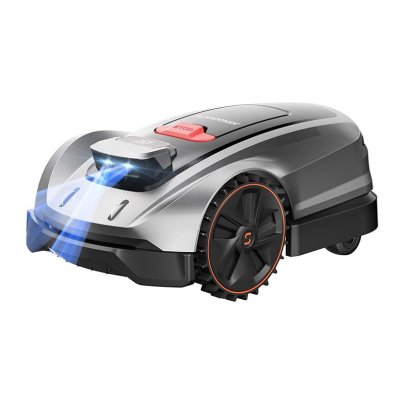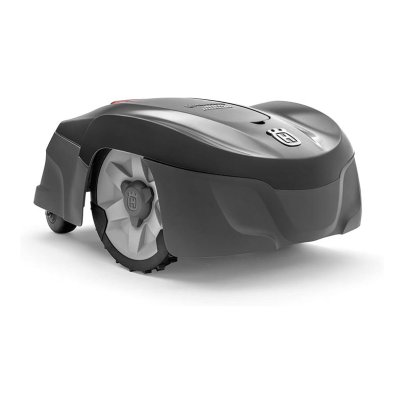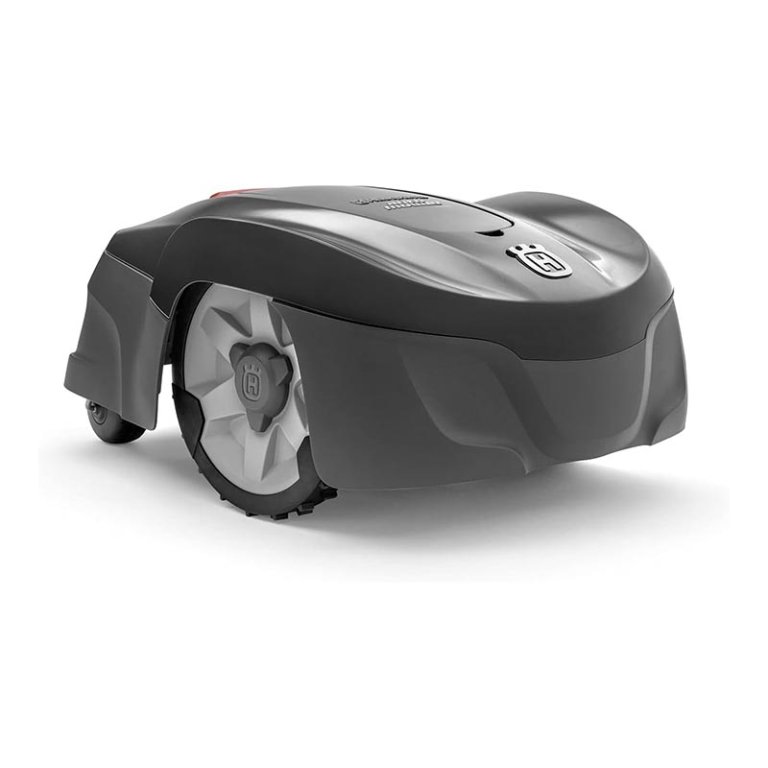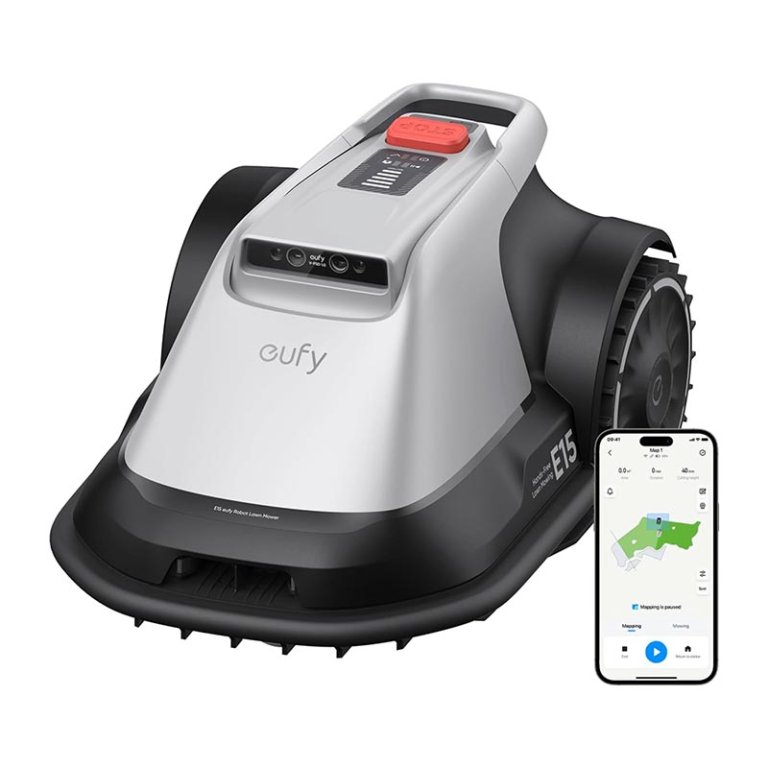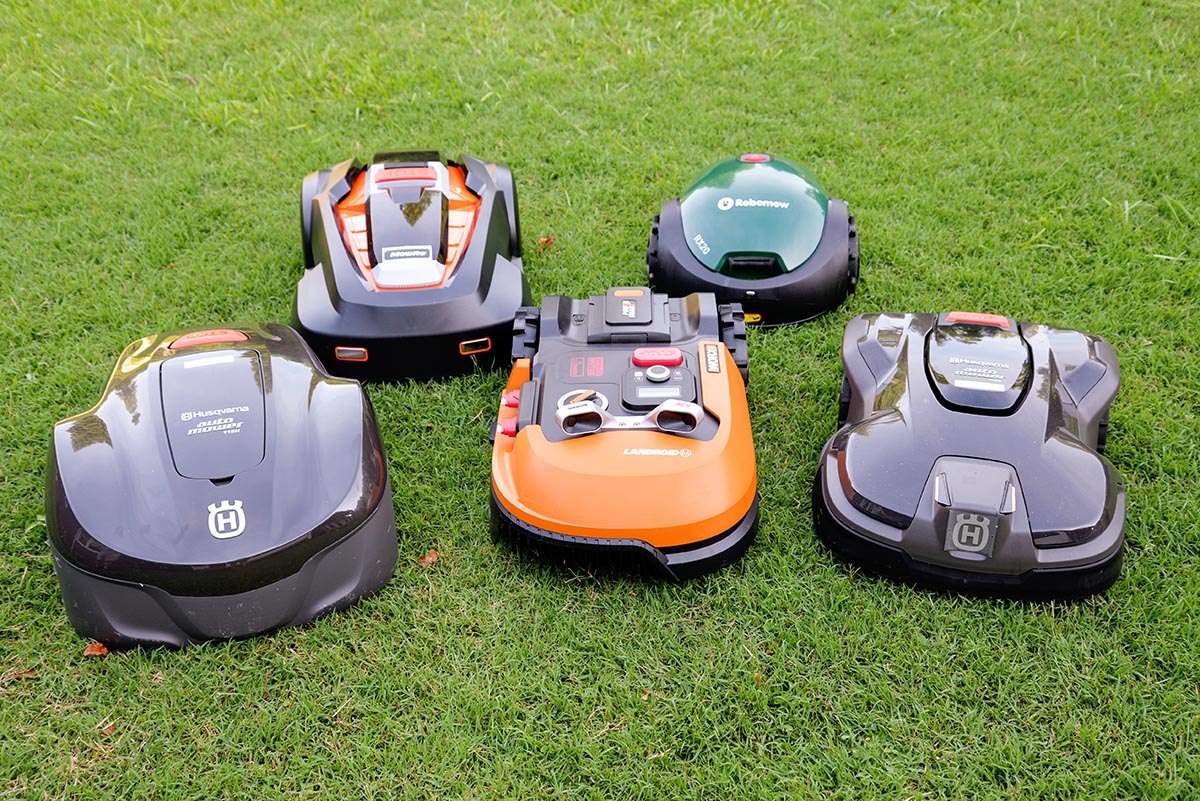
We may earn revenue from the products available on this page and participate in affiliate programs. Learn More ›

Save Hundreds on Two of Our Favorite Robot Mowers Now!
Get the Sunseeker robot mower for 25% off! That’s a savings of $400. With a quick setup and wire-free mowing, the Sunseeker’s ultra-sharp blades cleanly slice through shaggy lawns for a pristine yard.
The Husqvarna, which is already a great deal, is now an even better deal at just $599. This compact robotic mower easily navigates narrow passages and slopes, providing evenly cut grass on your schedule.
Whether you want to carve out more free time or reduce your carbon footprint, a robot lawn mower could be the answer. But do robots cut as well as a person pushing a mower? Equipped with cutting-edge navigation and obstacle avoidance technology to go along with advanced app-based controls, these autonomous devices leave lawns with the appearance of a perpetually fresh cut. They are easy to use and very reliable, but the technology has rapidly evolved since 2022, when BobVila.com started testing robotic lawn mowers. The latest models no longer require installing labor-intensive boundary wires. They run longer per charge, offer more customization options, and cut better than ever.
Our current favorite is the Segway Navimow. It cuts the most complex lawns guided by a vision-enhanced satellite navigation system. But it is a bit more expensive than some other options, and has a maximum area limit of a quarter acre. For smaller budgets or larger yards, we have other great options to choose from. In the reviews ahead we discuss how each selected robotic mower performed on our test turf. Afterwards, keep reading to learn about the criteria we used to select the best robot lawn mowers and find one that’s right for your lawn care routine.
- BEST OVERALL: Segway Navimow i Series Robot Mower
↓ Jump to Review - RUNNER UP: Sunseeker X3 Plus Robotic Mower
↓ Jump to Review - BEST BANG FOR THE BUCK: Husqvarna Automower 115H Robotic Lawn Mower
↓ Jump to Review - BEST APP CONTROL: Anthbot Genie 3000 Robot Lawn Mower
↓ Jump to Review - BEST FOR ACREAGE: Segway Navimow X390 Robot Lawn Mower
↓ Jump to Review - BEST W/O AN RTK ANTENNA: Eufy E15 Robot Lawn Mower
↓ Jump to Review - BEST MINI: YUKA Mini Robotic Mower
↓ Jump to Review - ALSO CONSIDER: Sunseeker X5 Robot Lawn Mower
↓ Jump to Review
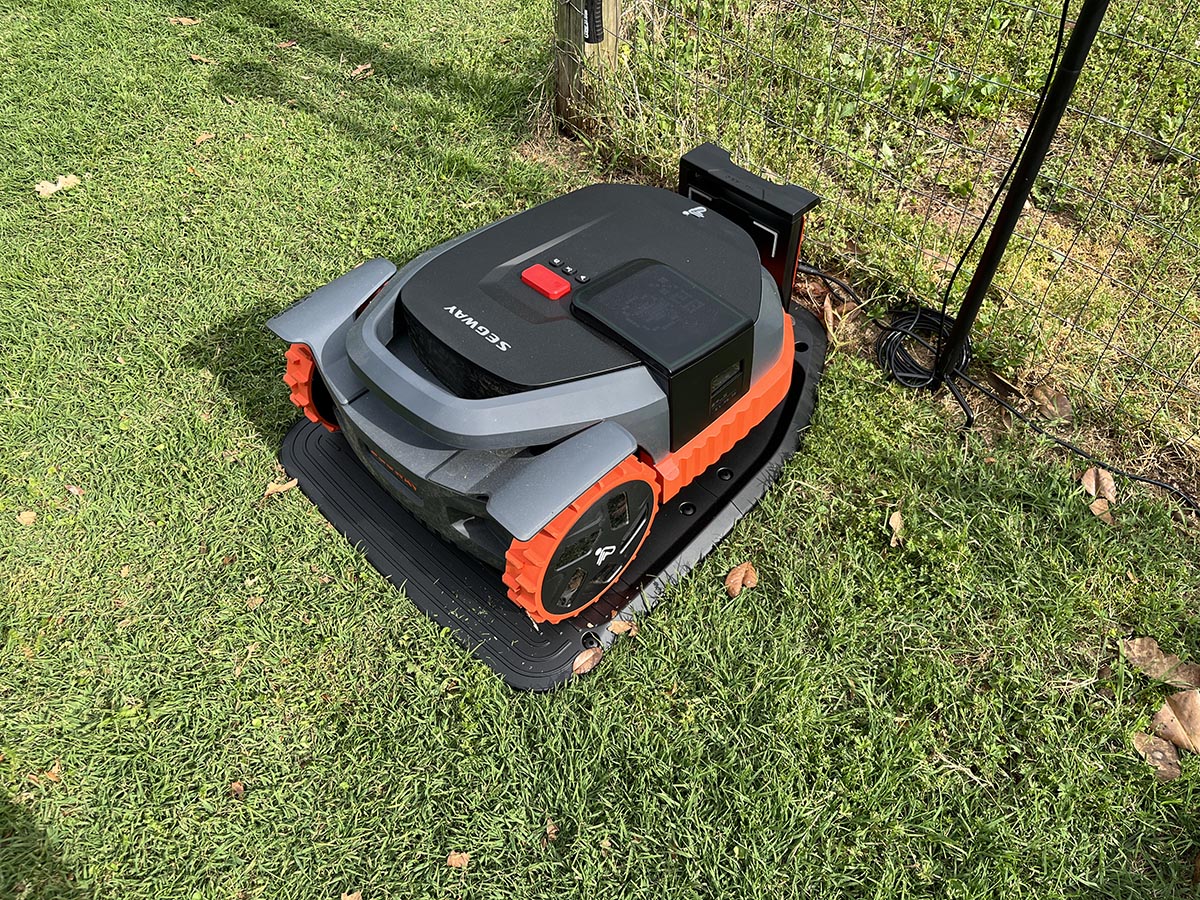
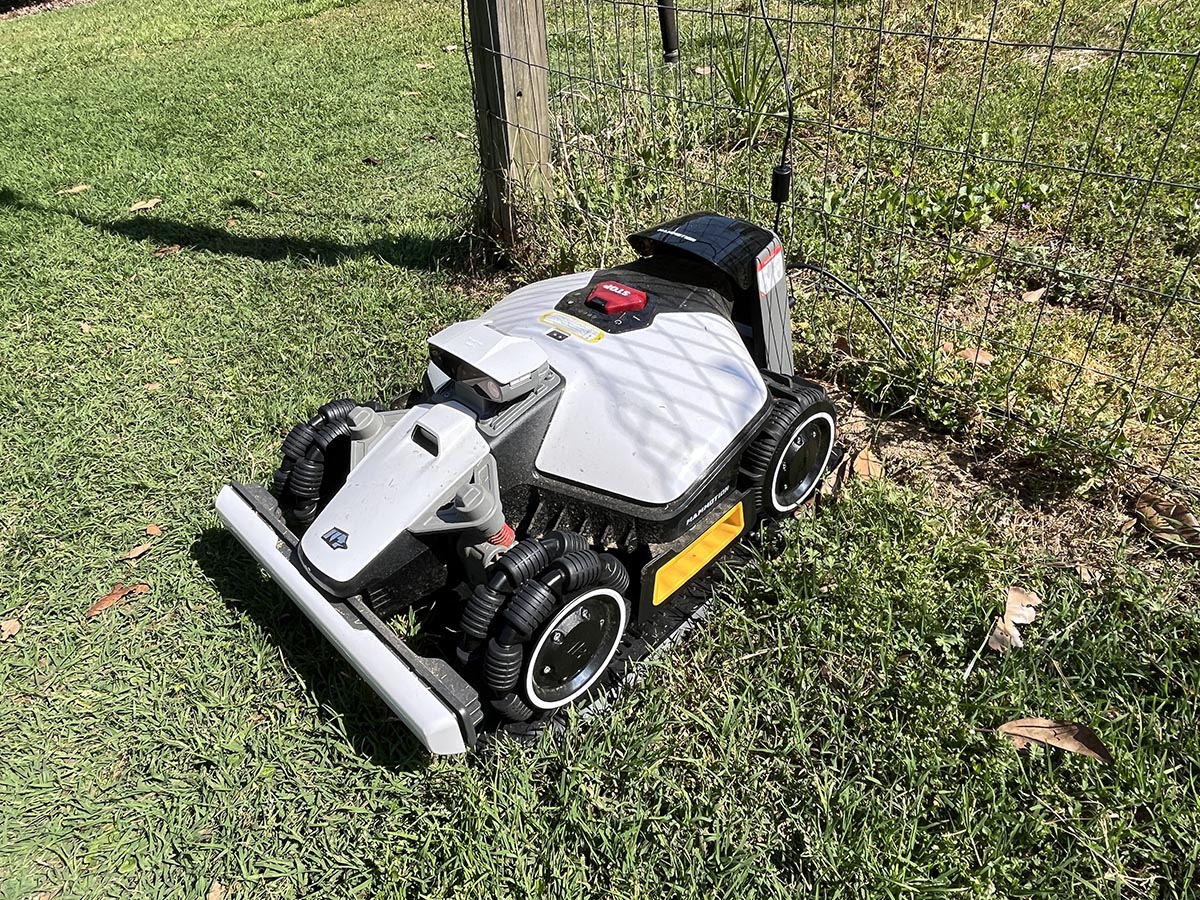
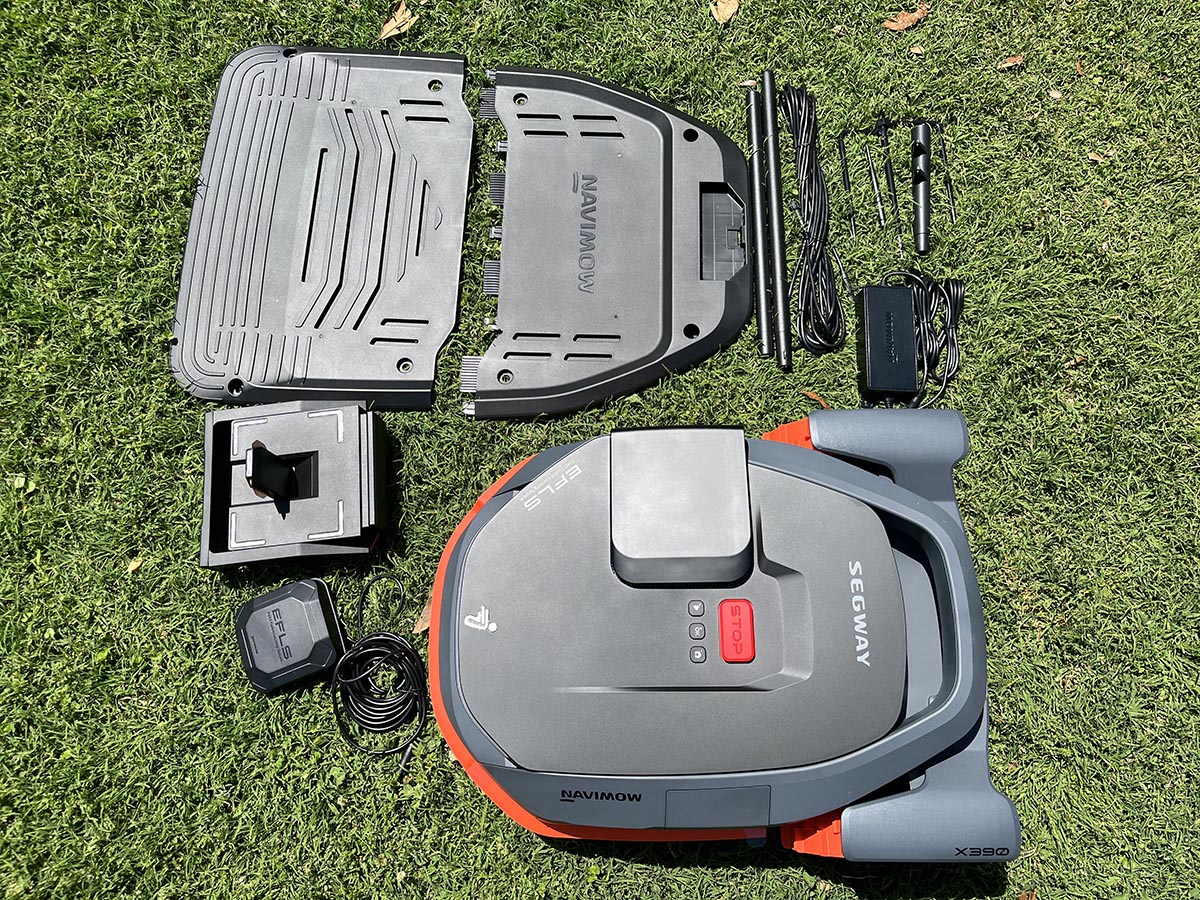
Our Top Picks
Best Overall
Photo: AmazonWhat We Like
- Precise EFLS satellite navigation system
- Onboard AI-enabled camera obstacle detection
- App mapping, scheduling, and mowing on demand
- Multizone and corridor programming options
What We Don’t Like
- RTK reference station requires unobstructed sky view
Specs
- Coverage area: 0.25 acre (up to 10,890 square feet)
- Mowing height range: 2 inches to 3.6 inches
- Slope rating: 17 degrees
Our Ratings: Ease of Use 5/5; Cut Quality 4.5/5; Performance 5/5; Durability 5/5; Value 4.5/5
For ease of setup and reliable navigation, a robot lawn mower with GPS can’t be beaten. Instead of a low-voltage boundary wire, Segway Navimow i110N uses an AI-enhanced satellite navigation system with centimeter-level accuracy to keep it in bounds. An onboard camera, also infused with AI technology, assists the satellite navigation system and helps the mower avoid obstacles.
The Navimow i110N can autonomously mow up to a quarter acre of grass, including slopes up to 17 degrees or about 28.5 feet of elevation change per 100 linear feet. The manual cutting height adjustment ranges from 2 inches to 3.6 inches high to accommodate most lawn grasses. It operates at a quiet 58 decibels, so it is safe for mowing any time of day, even in noise-sensitive neighborhoods.
Setup took about 2 hours, including installation of the charging base and antenna, downloading the app, and mapping the yard. The instructions were easy to follow. To map the yard, we used the mobile app as a remote control to steer the mower around the zone borders and any excluded areas. Driving the mower took quite a bit of trial and error. Scheduling was easy and very flexible. The app allows for multiple zones, travel corridors between zones, and multiple mowing cycles per day.
Navimow may also be an appealing option for those who like lawn striping. Unlike most other mowers in this guide, Navimow mows in parallel lines, producing a pinstriped appearance due to the 7.5-inch width of cut. During each mowing cycle, it cuts along a different axis: first north to south, next northeast to southwest, then east to west, and finally southeast to northwest before repeating.
The basic Segway Navimow i110N kit includes the mower, charging station, antenna, and power cord. The one we tested came with a few upgrade features, including the Garage S charging base shelter, the Access+ 4G signal backup module, and the antenna extension kit. We consider the Garage S a necessity as it added a layer of protection against sun, rain, dirt, and debris. Since the satellite signal in our yard was really good, we didn’t notice a difference after adding the Access+ and antenna extension. The mower stayed in bounds at all times, mowed on schedule, and had no problem keeping up with our quarter-plus acre of grass.
What our tester says: “It was the fastest and easiest to set up and the first model I’ve tested that was able to cut perfect lawn stripes instead of a random pattern.” —Mark Wolfe, Product Reviews tester and writer
Get the Segway robot lawn mower at Amazon or Segway.
Runner up
Sunseeker X3 Plus Robotic Mower
Buy at AmazonWhat We Like
- Precise EFLS satellite navigation system
- Sensitive 3D camera obstacle detection
- Intuitive app mapping and scheduling
- Up to 6 zones and corridor mapping
What We Don’t Like
- Antenna is difficult to stake and stabilize in hard ground
Specs
- Coverage area: 0.3 acres
- Mowing height range: 1.6 to 3.2 inches
- Slope rating: 30 degrees
Looking to keep your lawn in perfect condition? The Sunseeker X3 Plus shaves grass to 1.6 inches for a low, clean cut. Of course, you can raise the blade as well but the lower cutting option is effective and leaves shorter grass than many other models.
With a 0.3-acre range and up to 6 cutting zones, it’s super easy to custom-program the settings. We used this mower for nearly a month on a tricky property with one big front yard, another small strip of grass in the front and a backyard with a hot tub and garden area to avoid. We ended up creating several mow zones with passageways to travel between each zone.
The intelligence on this mower is really impressive. Using the app, we were able to create precise mow zones that require no wires. Setup took roughly one hour, and we especially appreciate the easy-to-follow in-app instructions. The only challenge involved finding a place for the satellite receiver. The rod has a generous length, and the cord is extra long, but it does require stakes to really secure the rod. A roof mount option would be really nice.
Once set up and running, this mower was a clear favorite. The blades cut well and are ultra-sharp, plus it came with extra blades and installation hardware. It also does great on slopes and hasn’t stuck once, although we did fill in a few holes and cleared obstacles.
The other area of high performance involved trees and planter boxes in the yard. The cameras were excellent, and the mower worked well around these obstacles. We spent some time testing the camera by walking in front of the mower and by introducing random objects like dog toys. It sensed everything and didn’t run over a single object. The camera system is pretty next-level.
Get the Sunseeker X3 Plus robot lawn mower at Amazon or Sunseeker.
Best Bang for the Buck
Husqvarna Automower 115H Robotic Lawn Mower
Buy at AmazonWhat We Like
- Height-of-cut range suits most types of grass
- Good performance on slopes up to 30 percent
- Intuitive programming via mobile app
- Program up to 3 different starting points
What We Don’t Like
- Only 60 minutes of runtime per charge
Specs
- Coverage area: 0.4 acre (up to 17,424 square feet)
- Mowing height range: 2 inches to 3.6 inches
- Slope rating: 17 degrees
Our Ratings: Ease of Use 4/5; Cut Quality 4/5; Performance 5/5; Durability 5/5; Value 5/5
The Husqvarna Automower 115H mows all kinds of grass up to 0.4 acre. Its durable 18-volt 2-amp-hour lithium-ion battery delivers 60 minutes of runtime per charge and recharges in just an hour. The cutting head manually adjusts from 2 inches to 3.6 inches for either warm-season or cool-season grasses, and it’s rated for slopes up to 17 degrees. Bluetooth connectivity lets users control the 115H via the Automower Connect mobile app. Adjust the mower schedule, start or stop mowing on demand, monitor status, and order replacement blades all in one convenient location. This wireless remote control lawn mower also has theft protection with a personal identification number (PIN) and alarm system.
The Automower 115H impressed us as a great choice for most suburban lawns. It easily navigated our test lawn’s slope and obstacles, reliably mowing on schedule and docking securely. The lawn’s appearance was consistent throughout testing, without any obviously missed spots. Working with the Automower Connect app, it was easy to program the schedule, set up different starting points, and pause and restart a mowing program during an active cycle. The guide wire helped the Automower navigate efficiently through a narrow corridor from one broad space to another.
It’s worth noting, however, that the lack of GPS technology makes this a “less smart” mower than some other models out there. For instance, the 115H did not seem to adjust its mowing patterns and obstacle avoidance as quickly as its more intelligent competitors did. But this model makes a great choice for larger yards and maintaining taller grass.
Get the Husqvarna Automower 115H robot lawn mower at Amazon.
Best App Control
Photo: AmazonWhat We Like
- App is intuitive and easy to use
- Handles thick grass effortlessly
- Easy custom zone mapping
- Adjustable mowing height
What We Don’t Like
- RTK antenna cable too short
- Dock placement options are limited
Product Specs
- Coverage area: 0.9 acres
- Mowing height range: 1.2 to 2.8 inches
- Slope rating: 24 degrees
Our Ratings: Ease of Use 5/5; Cut Quality 5/5; Performance 4.5/5; Durability 4/5; Value 4/5
The Anthbot Genie 3000 robot lawn mower impressed us right out of the box with its straightforward setup and polished app experience. Pairing the mower with the app was seamless, and creating a custom mowing map by manually guiding it around the lawn perimeter felt intuitive and quick. We appreciated how easy it was to divide the yard into sections, allowing more precise control over how and when each area was mowed.
Performance-wise, the Genie 3000 exceeded expectations. It tackled thick St. Augustine grass without issue—a rare feat in our experience with robot mowers, which often spin their wheels in frustration. The adjustable mowing height is a smart inclusion, and the mower transitioned smoothly between lawn sections with minimal input after initial setup. Our only real gripe lies with the RTK antenna: its short power cable restricts placement options and could complicate things if you’re hoping to hide the dock in a covered spot. A longer cable would solve this, but it’s not included.
Best for Large Acreage
Segway Navimow X390 Robot Lawn Mower
Buy at SoharsWhat We Like
- Largest coverage of any robot mower we have tested
- Up to 240 minutes of mowing per charge
- Wide, 9-inch cutting disc with six blades
- Fast mowing speed
What We Don’t Like
- One of the most expensive mowers tested
- Only moderate slope performance
Specs
- Coverage area: 2.5 acres (up to 108,900 square feet)
- Mowing height range: 2 inches to 4 inches
- Slope rating: 27 degrees
Our Ratings: Ease of Use 5/5; Cut Quality 4.5/5; Performance 5/5; Durability 5/5; Value 4/5
For those in need of a large lawn robot mower, the Segway Navimow X390 is built to handle up to 2.5 acres of grass. It moves fast, cuts a wide swath, and can mow up to 240 minutes per charge. This boundary wire-free robot mower uses satellite guidance through an RTK reference station, paired with AI-enhanced vision capability, to stay on track and avoid obstacles.
In our test yard, setup only took about 30 minutes. That included unpacking the kit, downloading the app, assembling the base station, connecting power and WiFi, and mapping the yard. Half of the time was spent mapping, so larger, more complex yards will take longer. Still, it was a far cry from the typical 90-plus minutes it used to take to set up perimeter wires. A cool feature that we did not test was the dual antenna system (we only had one antenna), which supports large, complex landscapes where signal drop could become a problem.
Like most of the other newer robot mowers, the Navimow X3 series is compatible with Amazon Alexa and Google Home. Unlike most of the others, it includes four layers of advanced security features: an out-of-bounds alarm, a lift alarm, GPS tracking via the mobile app, and secret compartments where third party item trackers may be stored onboard. As far as mowing is concerned, it also comes with a “Doodle” feature, a series of preset patterns that it can cut into the grass for a fun, decorative touch.
This machine is fast, averaging 1 meter per second. During the 2-week test period, the Navimow X390 mowed an average of 2,810 square feet per hour. It only took 1.9 hours to mow the same amount of space that required 2.25 hours or longer from the others in the test group, including some with dual cutting discs. The two key points of separation were the X390’s fast pace and big battery. It was one of only three mowers that was able to cut both zones without stopping to recharge. It made perfect parallel stripes, alternating the stripe directions from one cut to the next, and never left an uncut strip.
Get the Segway robot lawn mower at Sohars.
Best W/O an RTK Antenna
Photo: AmazonWhat We Like
- Syncs with popular EufyHome app
- No perimeter wires or RTK antenna needed
- Several incorporated safety features
- Onboard camera for real-time view
What We Don’t Like
- Best for low-growing grass
- Wi-Fi range limited to about 50 feet
Specs
- Coverage area: 0.2 acres (up to 8,712 square feet)
- Mowing height range: 1 to 3 inches
- Slope rating: 18 degrees
Our Ratings: Ease of Use 4.5/5; Cut Quality 4/5; Performance 4/5; Durability 4/5; Value 4.25/5
We’re big Eufy fans. So when the Eufy E15 robot lawn mower arrived for testing, we had high expectations. Setup was refreshingly simple—it’s about as close to plug-and-play as robot mowers get. The mower arrived well-packaged, and all we had to do was place the base station in a permanent location and plug it into an outlet. That’s the only wire involved. Unlike many robot mowers, the E15 doesn’t rely on boundary wires or an RTK antenna; instead, it uses advanced visual navigation to define its mowing zone. The E15 allows height adjustment from 1 to 3 inches, but in our testing, it performed best on grass 2.5 inches or shorter—making it a solid match for low-growing grass, such as buffalo.
Once fully charged (about 1.5 hours), we powered on the mower and the EufyHome app walked us through the setup and let us define the mowing boundaries. Like most robot mowers, the E15 works best on a frequent schedule—mowing daily or every other day keeps the lawn consistently neat and prevents it from getting overwhelmed. It cut well on our buffalo grass, navigating slopes up to 18 degrees and avoiding obstacles with ease. Still, it struggled to cut thicker, taller fescue.
The only real hiccup was with Wi-Fi connectivity—the mower began dropping signal once it ventured about 50 feet from the base. That’s something to keep in mind for large yards or weak Wi-Fi coverage outdoors. However, for those looking for a hands-off way to keep low-growing grass trim and tidy, the E15 delivers. It features a safety shutoff if it’s lifted or tipped, rain detection, and even GPS tracking and app-based locking to help prevent theft.
Get the Eufy E15 robot lawn mower at Amazon or Eufy.
Best Mini
Photo: AmazonWhat We Like
- Powerful wheel base, especially on inclines
- Excellent edge control and accurate obstacle avoidance
- App mapping, scheduling, and mowing on demand
- Multizone and corridor programming options
What We Don’t Like
- Satellite reference station requires unobstructed sky view
Specs
- Coverage area: 0.2 acre
- Mowing height range: 2 to 3.5 inches
- Slope rating: 27 degrees
Mammotion labels this as a small yard model but it’s more capable than I expected. Using the Yuka Mini on a front and back yard with some slope and difficult edges offered a reasonable challenge. The yard size approached the maximum area and it had no issues covering everything on scheduled mows. The model performed very well, covering the edges and thoroughly mowing the mapped area without fail or sticking over some difficult terrain.
Although it’s not an AWD model, the Yuka Mini handled tricky edges and managed to work through a few divots and funky yard sections. Moreover, mapping and setting up the system was surprisingly easy. In all it required roughly 30 minutes to set up the base charging station, RTK station and to map out the backyard. Not bad, especially when compared to other models.
The only challenge involved finding a clear view for the RTK receiver. The yard has a few tall buildings and trees but with some testing in different locations, I eventually found a solid connection point. I do love the stake style pole and multiple mounting options for the receiver. In the weeks of testing, I used the stake but plan to mount the receiver on a roof for long term use.
Over the course of several weeks, I scheduled mows for every other day. The property is a vacation rental and the quiet nature of the mower offered a major advantage over traditional gas models. The ability to schedule mows while the property was occupied without disturbing guests was also a huge time and schedule convenience on my end.
What our tester says: “I was impressed with the app capabilities and ease of setup. I had the yard mapped and mows scheduled in no time at all. I watched the first mow and made a few tweaks to get the base station level and to remove a few rocks and obstacles in the yard. After the initial mow, it ran on schedule with no maintenance or interference. I can’t believe how much easier this makes yard maintenance at my vacation rental property.”
Get the Yuka Mini robot lawn mower at Amazon or Mammotion.
Best for Sloped Lawns
Photo: The Home DepotWhat We Like
- All-wheel drive handles slopes with ease
- Accurate RTK antenna navigation
- User-friendly app and mapping setup
What We Don’t Like
- Manual cutting-height adjustment
- Must redo maps if dock is moved
Specs
- Coverage area: 0.5 acres (up to 21,500 square feet)
- Mowing height range: 1.18 to 3-15 inches
- Slope rating: 30 degrees
The Sunseeker X5 is a sleek, all-wheel drive mower that’s built for tougher terrain. Unlike boundary-wire models, it uses an RTK antenna for mapping, which means you’ll need to place the antenna where it has a clear view of the sky. While this setup isn’t my favorite because it requires finding a good mounting location, it pays off with superior accuracy once installed.
In testing, the X5 impressed me on my uneven Florida lawn with thick St. Augustine grass. The all-wheel drive system allowed it to climb slopes and maneuver bumpy patches without spinning its wheels or skipping spots—a problem I’ve seen with other models. The app setup was smooth and intuitive, letting me drive the mower around to establish the initial map. Just note that if you move the docking station or antenna, you’ll need to redo the mapping process.
One downside is the manual cutting-height adjustment dial on the mower itself; it would be nice to see this feature integrated into the app. Still, because mowing height isn’t something you’ll frequently change, this is more of a minor inconvenience than a dealbreaker. Overall, the Sunseeker X5 delivers powerful, precise performance for homeowners with larger or sloped yards who need a mower that won’t get lost or bogged down.
Get the Sunseeker X5 robot lawn mower at The Home Depot or Sunseeker.
Jump to Our Top Picks
How We Tested the Best Robotic Lawn Mowers
| Testing Stats | |
|---|---|
| Products tested | 14 |
| Time spent testing | 6 months |
| Tests performed | 9 |
| Price range | $600 to $5,000 |
When we started testing robot lawn mowers just a few years ago, they all used perimeter guide wires for navigation. Some of our early favorites included Worx Landroid and Husqvarna Automower, and they are still great options for affordable automated lawn mowing. In order to keep up with the latest technology and showcase the best of the best, we test new mowers each year. Now, nearly every new model features perimeter wire-free navigation, powered by either satellite guidance or AI-empowered vision technology.
To test them, we set up each mower, programmed a weekly schedule, and let it go for two weeks. Our test yards include typical obstacles and mowing challenges like trees, landscape beds, slopes, uneven ground, narrow corridors, and different types of grass. Our “Best Overall” robotic lawn mower has to reliably navigate the lawn while avoiding permanent and temporary obstacles, always stay in-bounds, mow with accuracy and consistency, reliably return to its charging station, and automatically avoid working in poor conditions. We use our observations to rate each mower on ease of use, cut quality, performance, durability, and value.
| Product | Ease of Use | Cut Quality | Performance | Durability | Value |
| Segway Navimow i Series Robot Mower | 5 | 4.5 | 5 | 5 | 4.5 |
| Sunseeker X3 Plus Robotic Mower | 5 | 5 | 5 | 5 | 4.5 |
| Husqvarna Automower 115H Robotic Lawn Mower | 4 | 4 | 5 | 5 | 5 |
| Anthbot Genie 3000 Robot Lawn Mower | 5 | 5 | 4.5 | 4 | 4 |
| Segway Navimow X390 Robot Lawn Mower | 5 | 4.5 | 5 | 5 | 4 |
| Eufy E15 Robot Lawn Mower | 4.5 | 4 | 4 | 4 | 4.25 |
What to Consider When Choosing a Robot Lawn Mower
Shopping for a robotic mower is a lot like shopping for a normal one, but there are a few extra things to consider when assessing this new gadget for your home. The following factors should help decide which robotic lawn mower is right for you.
Yard Size
To begin the search for a new self-mowing robot, get an accurate measurement of the area it will mow. Measure the lawn’s square footage, not the size of the lot, and exclude square footage taken up by the house, driveway, landscape beds, and any other feature that is not grass. Often only half of the square footage of a residential lot is lawn space, and sometimes even less.
Light-duty or portable lawn mowers are best for areas up to a quarter acre, or about 11,000 square feet. Midsize models cut up to a half acre, or about 22,000 square feet. Large machines can cut an acre, or 43,560 square feet, or even more.
Factors that affect how much space a mower can cut include battery runtime per charge, the mower size, and the speed it travels. The “up to X square feet” amount that manufacturers claim is calculated with ideal mowing conditions in mind. Mowing conditions including slopes, obstacles, and irregular lawn shapes, as well as grass type, thickness, and growth rate, may all inhibit a mower’s efficiency and capability.
Look for a mower that can cut the entire yard on a single battery charge, if possible. For larger yards, it may be necessary to divide the lawn space into two or three smaller mowing zones that the mower can cut on different cycles. Not all robotic mowers have the ability to create and schedule multiple zones, so be sure to buy a mower with that capability if necessary to suit the property size.
Terrain Handling
Basic robot mowers work on flat yards and slopes of up to 15 percent (1.5 feet of rise per 10 feet of linear distance). Yards with garden beds, boulders, pathways, and/or steeper slopes require a more capable model. Look for one with onboard collision-detection systems, GPS, all-wheel drive, and/or multizone programming capability to navigate complex yards.
Mowing Height
Grass type, weather conditions, and terrain influence a lawn’s optimal mowing height. Warm-season grasses like Bermuda, zoysia, and centipede should be mowed to from 1 to 3 inches high, while cool-season grasses such as fescue, bluegrass, and perennial ryegrass should be mowed to between 2.5 and 4 inches.
That said, allowing grass to grow taller than normal in extreme heat and drought helps protect the roots from dieback. Smooth, flat ground makes it easier to mow lower, while rough terrain requires additional clearance. We recommend buying a robotic mower that allows as much mowing height flexibility as possible within the range for the particular lawn type.
Controls
Robot and remote control lawn mowers are kept in the yard either by a low-voltage electric perimeter boundary wire or more commonly by satellite guidance or AI-supported vision technology. The wire or the smart features help the mower locate the edges of the lawn and steer around permanent obstacles like trees, paved areas, and buildings. An onboard computer tells the mower when to mow and when to recharge. Just program the mowing schedule and set the blade height, and the lawn mower does the rest. Many robotic lawn mowers are Bluetooth capable or Wi-Fi connected, so it’s an option to program them with an app on a smartphone.
Power Source and Battery Life
Robot mowers charge automatically at a home base station. The base station serves as the charging port and the boundary wire hub. The same power source that charges the mower’s battery also sends a low-voltage current through the boundary wire, if installed, to guide the mower. A single power cord plugged into a nearby ground-fault circuit interrupter household outlet provides the needed electricity.
These mowers typically use rechargeable lithium-ion batteries, though some use lead-acid batteries or other types. Depending on the model and mowing conditions, an electric mower can operate between 1 and 2.5 hours per battery charge. Batteries typically need 30 minutes to an hour to recharge. Robot lawn mower batteries tend to last approximately 3 years on average.
Smart Technology
Onboard sensors, Bluetooth connectivity, mobile apps, and compatibility with personal digital assistants all let users program a robotic mower. On its programmed mowing schedule, the mower starts and recharges itself, returning to its docking station when it has finished the job. The mowers’ programming keeps it on the lawn and protects non-grass areas.
Some robotic mowers have a manual mode used to trim enclosed spaces. In manual mode, the robot mower can be moved to a secondary location—inside a fenced area of the yard, for example—and it will mow without further programming.
Many robot mowers will alert smartphones when there is a problem, if its blades need to be changed, or if the machine is moved off the premises. Mobile apps can also allow the robot mower to be monitored and controlled remotely via a smartphone or digital assistant.
Noise Levels
Robotic mowers are quiet but not silent. They produce an average of 50 to 70 decibels, which is similar to the sound levels of a quiet refrigerator, a calm conversation, or the noise inside a car traveling at 60 miles per hour. A gasoline-powered push mower produces 95 decibels, or about 50 percent more noise than a self-cutting lawn mower.
Security
Robot lawn mowers are small enough that a thief could carry one away. For that reason, many models require a PIN for operation. Others feature alarms, security alerts, and GPS tracking that kicks in if the unit is removed from the owner’s property. Since robot lawn mowers are fairly quiet, people often program them to run at night as a theft deterrent.
Safety Features
Robot lawn mowers have safety features to protect the user and others in their cutting area. The machine moves slowly so pets, children, and others can see it coming and get out of the way. Collision sensors slow or redirect the mower as it nears an obstacle. An automatic shutoff kicks in if the machine is lifted, stopping the blades from moving. And the mower has recessed blades mounted away from the edges of the machine to reduce the chance of cutting hands and feet that come too close.
Weather Protection
Most motorized lawn mowers are built to withstand outdoor conditions during the mowing season. Some robotic mowers can run in the rain, but it is not recommended since wet grass doesn’t cut as smoothly, and wet conditions can spread fungal diseases to the lawn. Some robot lawn mowers have rain sensors that stop, skip, or delay a scheduled mowing in rainy conditions. Other robot mowers can have their cutting schedule manually overridden, so users can turn them off if rain is in the forecast. Still others link to a weather app that will turn the mower off if rain is predicted.
Docking stations are weatherproof during the mowing season. Still, in stormy weather where lightning is predicted, unplugging the system provides the best protection. Extended periods of damp, subfreezing weather shorten the mower’s lifespan, so the mower and its docking station should both be stored indoors in the winter.
FAQs
An automatic lawn mower can be a great asset for homeowners who want to spend less time mowing their lawn. Still not sure if a robot mower is right for you? Read on for info and tips to facilitate your decision.
Robotic mowers are designed to cut several times per week. When grass is growing really fast, the robot mower should run every day or every other day. When grass grows more slowly, mowing two or three times per week is sufficient. Follow other best practices for how to mow a lawn.
Some robotic mowers can operate in the rain; others cannot. However, mowing only while the grass is dry results in a cleaner cut and reduced disease spread in the lawn.
A properly maintained mower should last 10 years or more. Mower blades last 1 to 2 months. They cannot be easily sharpened; they must be replaced—think of them as disposable razor blades. Rechargeable batteries for robot mowers last about 3 years, on average.
Manufacturers will provide an “up to X square feet” amount for a particular model. However, this number is calculated with ideal mowing conditions in mind. Slopes, obstacles, and irregular lawn shapes as well as grass type, thickness, and growth rate may all affect how much a grass cutting robot can handle in one charge.
Some models require a perimeter wire, which increases setup and winterizing time. Depending on the mower and the size of the lawn, it can potentially run out of charge in the middle of a job and require recharging before continuing. The device can also leave an unmowed strip around the edge of a lawn that will later need to be trimmed by hand.
Robotic mowers produce an average of 50 to 70 decibels, which is similar to the sound levels of a quiet refrigerator. In comparison, a gasoline-powered push mower produces 95 decibels.
Yes, an automated lawn mower can chop leaves into smaller pieces that can then be used to mulch a lawn. Some models even have a mulching function. However, although most models can chop up a few incidental leaves, they’re not designed to mulch large quantities.
Meet the Testers
Paul Rankin is a home improvement writer and product tester with a background in hands-on DIY and a sharp eye for practical tech. He specializes in reviewing tools, outdoor gear, and smart home products, bringing real-world experience and a straightforward, no-nonsense approach to every test.
Glenda Taylor is a product tester and writer specializing in the construction, remodeling, and real estate industries. She tests a wide range of power tools as well as other home improvement, household, and lawn-and-garden products.
Mark Wolfe is a writer and product tester with a background in the nursery and landscaping industry where he mowed, edged, planted, pruned, cultivated, irrigated, and renovated beautiful landscapes. Now he tests and writes reviews about the latest outdoor power equipment, hand tools, lawn care products, and other outdoor living goods.
